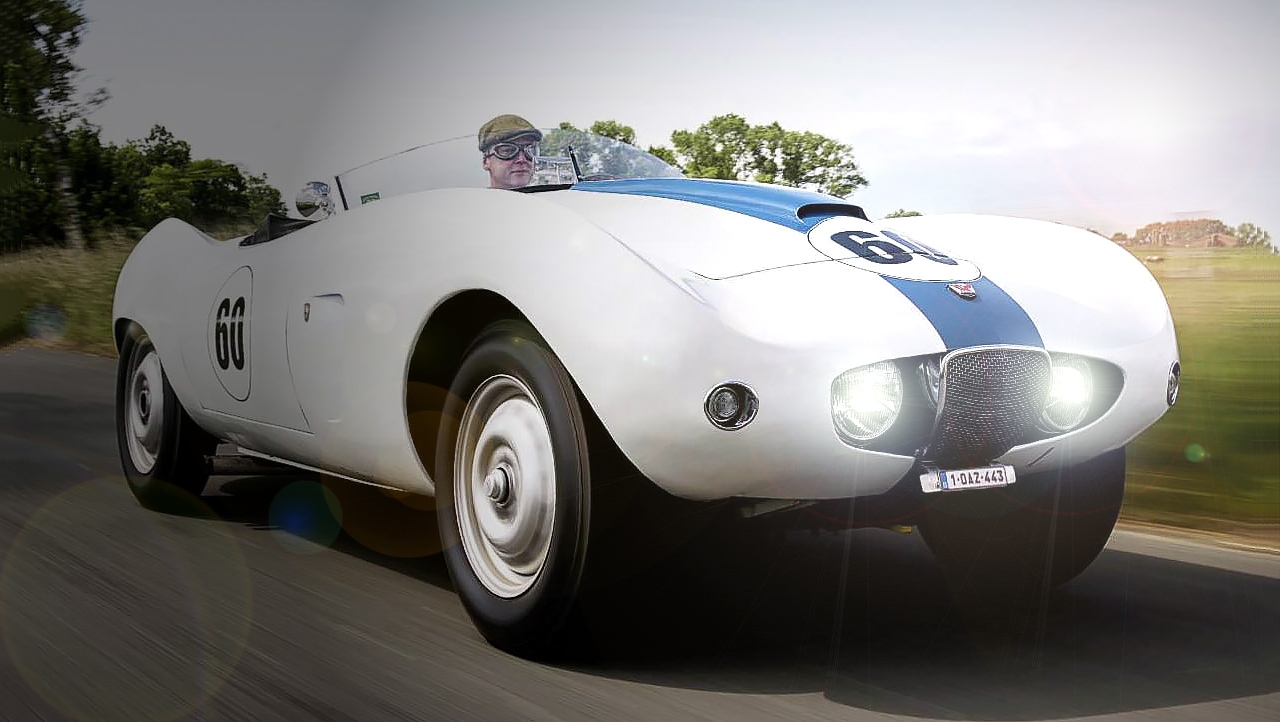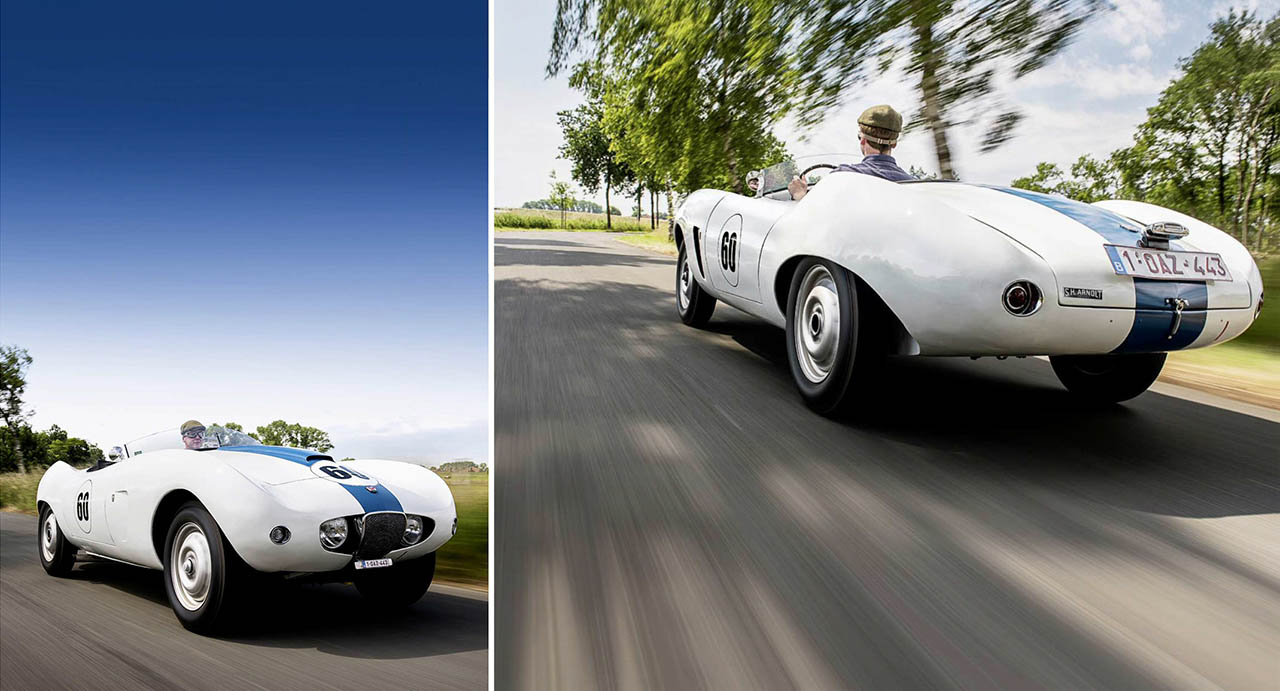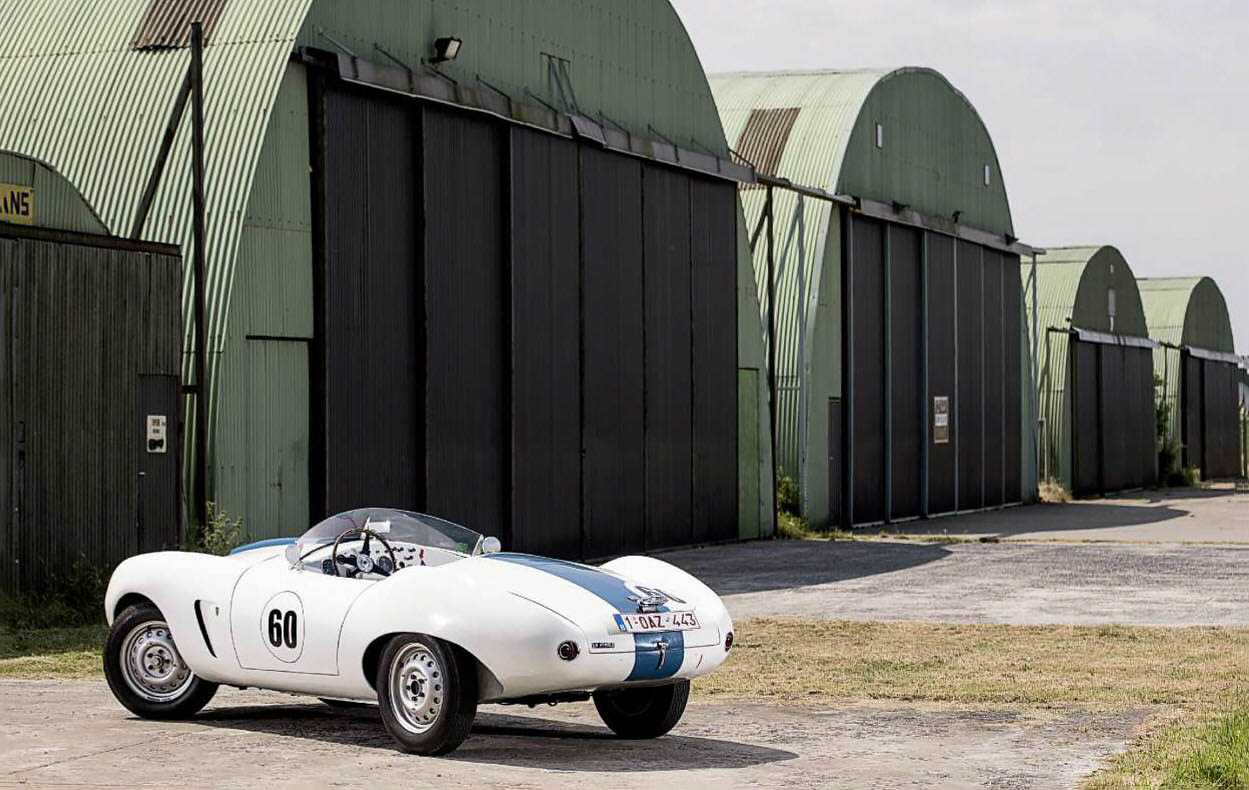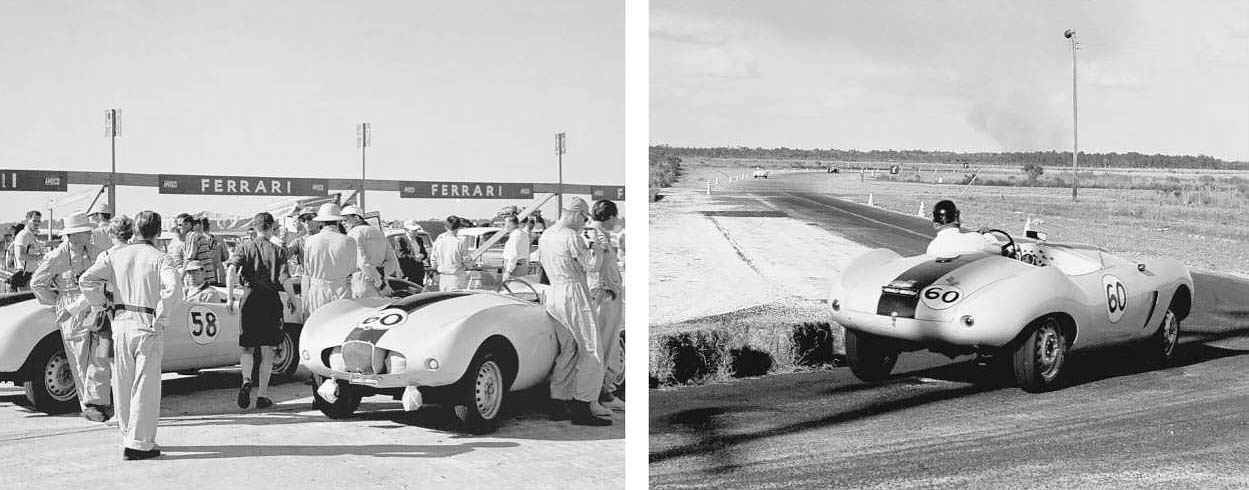
Flight DECK. Arnolt-Bristol Three of these curvaceous Bertone-built racers took the Sebring 12 Hours by storm in 1955. We drive the car that may have pulled off a spectacular class win. We take to road and track in the Bertone beauty that took on the sports car establishment – and won. A three-car team of Arnolt-Bristols took on the sports car establishment in the 1955 Sebring 12 Hours race. We get a taste of the action. Words Phil Bell. Photography Dirk De Jager.
A ferocious airstream is channeling between two Bertone-sculpted wings, kicking up over a meagre few inches of aero screen and attacking my head, stinging my face and tugging vigorously at my hair and goggles. I think Lieven Goeman might be asking me what I think of his 1954 Arnolt-Bristol Bolide, but his words are torn away into our slipstream as we hurtle along this free-flowing stretch of Belgian autoroute. The thrill of driving this elemental piece of technology at speed prompts a delirious grin in reply.
As I dodge around clusters of high-speed commuters, my brain flits between the excitement of now and a growing sense of connection to the team that drove car number 60 to a sports two-litre class win in the 1955 Sebring 12 Hours. The pairing of John Panks and Ernie Erickson was part of a three-car team entered by the Arnolt team.
Team owner Stanley ‘Wacky’ Arnolt and co-driver Bob Goldich brought car 59 home second in class and only the Morgan of Rothschild and Kunz kept the Arnolt-Bristol of René Dreyfus and Robert Grier, wearing number 58, out of third. Yes, that René Dreyfus. The ever-persuasive Arnolt somehow managed to charm the 50 year-old French former F1 star-turned New York restaurateur out of motor racing retirement to become team manager for the weekend.
It was a chaotic year in which 20 of the 80 qualifiers were denied permission to start in an attempt to weed out some of the less expert drivers. Six of them joined the race anyway! Later in the race Jean Rédélé overturned his Renault 4CV, and with no marshals on the scene to warn other drivers Bob Said wrecked the attending ambulance with his Ecurie Yankee Ferrari 500 Mondial during a last-minute swerve to avoid the stretcher bearers.
As I turn in to Flanders International Business Airport and park up, I hope there will be no ambulances or wide-eyed medical orderlies to avoid on these runways, the nearest location that Lieven could find to the car’s natural racing habitat. The car seems drawn towards the near-100-year-old corrugated steel hangars crouching ominously to my left.

As I watch a momentary wash of sunlight sheen softly off the white paintwork and warm up the Cadillac Cobalt Blue stripes, I’m struck by how the Italian looks – a hint of the radical Bertone BAT 5 show car that shook the world in 1953 – really are just skin-deep on this car. The Bristol 404-derived chassis and American market focus mean that I’m stretched out in a generous cockpit with a comfortable ratio between pedal distance and steering reach. Time to peel back some more layers of its character. I twist the tiny ignition key clockwise, push the starter button and the sixcylinder Bristol engine explodes back into life, the lumpy, chugging throb from the side exhaust overlaid with busy valvegear thrash.
The lengthy gearlever sprouting up from the transmission tunnel doesn’t look promising, but slips lightly into ratio when I palm the gearknob towards first. Still feeling my way into the drive, I squeeze lightly on the throttle and ease up the clutch, only to be punished by the aggressive camshaft profiles that turn the normally sweet-natured engine into a fluffing, spitting beast that stumbles the car forwards with cantankerous reluctance. So I recalibrate my driving style, digging generously into the throttle travel to properly open up those three Solex 32BI carburettors before stepping more smartly off the clutch. This time the Bolide snaps sharply away from rest, the thudding exhaust note smearing out into a high-pitched war cry as the tachometer needle swoops past 3000rpm.
Fingertip guidance is enough to move the gearlever through its long journey across the gate to second but it must be done with patience for it to slot home cleanly. Perhaps the clutch needs adjustment to achieve the normally slick change. It’s the same up into third before I can release the clutch and jump back on the power, exhaust blatter turning to blare as I reach for the full 130bhp at 5500rpm. This 1971cc engine is one of life’s great pleasures – sweet-revving, gutsy and cleverly engineered beyond its BMW 326 origins by Rudolf Schleicher, and further evolved by those aircraft-minded chaps at Bristol. He concocted the induction arrangement that had the overhead inlet valve rockers driven conventionally from the camshaft by vertical pushrods, while the exhaust valve rockers used transverse pushrods reaching across the aluminium cylinder head. It allowed space for hemispherical combustion chambers and, in this Bristol Sports 1 version of the engine, nice big 39mm inlet valves and 33mm outlets to really get the gases flowing. So in this 962kg machine it’s obvious that it was powerful enough to take on everything from the Morgans to the Siatas of the day.
The runway helps me to appreciate how those Bristol chassis would have coped with the Sebring circuit 50 years ago. Spearing towards a tight right-hander I have to push hard on the brake pedal; there’s little travel and it feels slightly dead. I press harder still and the nose dips a little, speed falls and I can feel the big brake shoes grabbing at the inside of the drums, so I back off a smidge to avoid a lock-up.
I guide the slim steering wheel to the apex and feel the Arnolt roll smoothly against its front transverse leaf spring and rear torsion bars. A mid-corner bump sends a kick and waggle through the massive horseshoe-shaped box section chassis to the hip-hugging seat, then the car immediately returns to tracking true. All the while the rack-and-pinion set-up responds instantly to tiny corrections. Back on the straight, a concrete expansion joint sends a jolt through the suspension and a big but brief shimmy through the wheel. It’s as if it has its own language – a mash-up of British, Italian and American, now being spoken here in Belgium.
For all the busy flow of information coursing through the wheel, the pedals, the air about my face and the seat, the car feels balanced as it carves through corners without any noticeable intent to push out either the front or rear Dunlops. It’s a car that I quickly trust to do as asked without any threat of betrayal. It doesn’t even feel like it would punish me if I made a hash of things, though smooth, precise inputs elicit the best rewards.
The Arnolt-Bristol’s user-friendliness would have helped its drivers on that warm, dry day in March 1955. While Mike Hawthorn’s Jaguar D-type led the big guns – including Phil Hill and Piero Taruffi in Ferrari 750 Monzas and Stirling Moss in an Austin- Healey 100S – the Arnolt-Bristols were pedalled by a largely amateur crew. Englishman John Panks was moonlighting from his day job as managing director of Rootes USA and had some experience, including a 1.5-litre class win at Edenvale in Canada at the wheel of a Sunbeam Talbot during his previous Rootes posting.
Ernie Erickson came with a wealth of experience, particularly in the Midwest where he earned the nickname ‘King of Wilmot’ after his lap record at the Wilmot Hills circuit. But at Sebring he stepped afresh into the Arnolt-Bristol from his familiar Jaguar C-type. The three-car team led its class for much of the race until lighting and brake problems for Dreyfus and Robert Grier allowed the Morgan Plus 4 of Mike Rothschild and Harold Kunz to split the pack. Brake fade and shoe wear would be a persistent blight for the Arnolt-Bristols, requiring regular pit stops for replacement.
As the chill of night descended the Hill/Shelby Ferrari was struggling to keep up with the leading D-type of Hawthorn/Walters, their smoky Monza adding fading brakes to the challenge. But come the final hour the determined Shelby, arm still in a cast from a prior accident, was still chasing down Walters. When rockets signalled the 10pm finish, he was one of 49 finishers from 80 starters. A race that started in some chaos managed to finish with uncertainty and protests over who had actually won. In the end Hawthorn and Walters were declared outright winners by 25.4 seconds.
The Arnolt-Bristol team filled two of the two-litre podium slots once more at Sebring in 1956, but this time class victory went to the Ferrari 750 Monza of Porfirio Rubirosa and Jim Pauley. The team returned with three cars plus a reserve for 1957, but tragedy struck early in the race after Bob Goldich took over car 39 from Stanley Arnolt. Wacky had warned of a problem with grabbing brakes, but Goldich was blinded by the sun while trying to make up lost time, swerved and overturned with fatal consequences. Arnolt returned to Sebring in 1959 with a sole entry co-driven by Max Goldman and Ralph Durbin for a fourth-in-class finish.
The following year was a bolder effort with three new cars including two with aluminium bodywork. The team was rewarded with first in the two-litre class for Goldman and Durbin plus a fourth, but the same cars locked out the Grand Touring 2000 class podium for their Sebring swansong in 1961.
Combine that with a string of class wins and strong finishes in SCCA races and you have to credit Arnolt with remarkable success for such a small-scale manufacturer. The chassis number sequence suggests that 142 cars were built and the notice of arrivals data says 134, but Bristol boss Tony Crook reckoned it was actually fewer than 100. You’d have expected more given how well received the car was, but Arnolt had lost interest. Crook believed that he simply tired of the everyday hassles of motor manufacturing, having enjoyed the glory of creating his own car.
Benjamin Franklin’s quote, ‘If you want something done, ask a busy person,’ seemed perfect for the prolific Arnolt. Having built his fortune manufacturing marine engines for wartime use, his fertile mind soon diversified into furniture, camping trailers, pilot ejector-seat mechanisms, cars and more.With distribution and import rights for all manner of British marques including Aston Martin, Bentley and MG in the American Midwest, it seemed inevitable that his thoughts would have turned to creating a car under his own name. A meeting with Nuccio Bertone on his 1952 Turin show stand revealed a thin order book for the talented Italian coachbuilder, thanks to crushing 35 per cent government duties. So Arnolt poured in some money, established himself as vice president and set about generating some business. A deal to buy 100 coupé and 100 cabriolet versions of Bertone’s-special bodied MG TD was a good start but Arnolt soon had bigger ideas.
Cue a meeting with Bristol export sales manager James Watt at the 1953 International Motor Show in New York. The $6750 Bristol 401 was proving a hard sell so Arnolt’s solution was to build a lightweight sports car on a British chassis clothed in simple, inexpensive bodywork. The Bristol 404 coupé, based on a 403 chassis shortened by 18 inches, was surely the ideal starting point on which Bertone’s Franco Scaglione could work his magic.
The chassis used the CR9 gearbox and 11-inch drums from the 403 saloon but needed minimal changes apart from the steering column rake and new fuel tank. The BS1 engine was modified with lightened valvegear, a hotter camshaft and a higher, 9:1 compression ratio, 39mm inlet valves, higher-flow oil filter and a Vokes air filter. Complete chassis were sent to Turin by train to be bodied by Bertone before being shipped to Arnolt’s base inWarsaw, Indiana.
The $3995 Bolide comfortably snuck under Arnolt’s original $4500 target, while the DeLuxe, with a full screen, hood, sidescreens and bumpers cost $4995. For $5995 you could have bought one of four, possibly six lushly-trimmed coupés. Sports Cars Illustrated typified the press reaction. ‘The Arnolt- Bristol is one of the finest high-performance sports cars I’ve ever driven.’ Surely this was the start of something big.
I clamber out of the Bolide for the last time and wonder why it didn’t make more of a dent in sports car history. For all of its clever fusion of British, Italian and American thinking, the relatively weighty Arnolt-Bristol could only ever mix it with sub-two-litre rivals, rarely dominating them outside of Sebring’s endurance arena where toughness and driver-friendliness meant they could outlast more highly stressed machines.
But those achievements on the Florida circuit stand tall. Driving Lieven’s car today reveals how complete the Arnolt-Bristol was, a precision tool with a hardened steel tip. Remarkable, when you discover that it went from concept to car in just six months.
Thanks to: Ann D’Aubioul, Flanders International Airport; Kenneth Andrén, John Simmons and Michael Arnolt of the Arnolt-Bristol Registry, Bristol Owners’ Club
1954 ARNOLT-BRISTOL BOLIDE
Engine 1971cc inline six-cylinder, ohv, three Solex 32BI carburettors
Power and torque 130bhp @ 5500rpm; 128lb ft @ 5000rpm
Transmission Four-speed manual BWCR9, rear-wheel drive
Suspension Front: upper wishbones, transverse leaf spring, anti-roll bar, telescopic dampers. Rear: triangular differential location bracket, torsion bars, telescopic dampers Steering Rack and pinion
Brakes 11in (403) hydraulic drums front and rear
Length 167in (14ft 3.5in)
Width 68in (5ft 8in)
Weight inc fuel 962kg (2120lb)
Performance 0-60mph: 8.6sec; top speed: 125mph
Fuel consumption 24mpg
Price new $3995

Arnolt-Bristol bodywork is steel to keep repair costs down.
‘The Bolide snaps sharply away, the thudding exhaust note smearing out into a high-pitched war cry as the tachometer sweeps past 3000rpm’

Neutral handling made the Arnolt-Bristol a race-friendly weapon.

BS1 MkII Bristol straight-six derived from the F2 engine. Flat-surfaced dash is specific to no-frills Bolide.
OWNING THE ARNOLT-BRISTOL
Lieven Goeman wanted something more powerful than his Porsche 356. ‘I found out about this wonderful Arnolt- Bristol race car that had won the Cartier Concours at Goodwood.’ After just 100km of motoring he realised that it needed work. Then he received the call from the restorer. ‘They said, “It’s not a car, it’s filler” and when I visited it was horrible – a patchwork of welds and old accident repairs. And a cardboard box full of filler – it was as thick as my hand in places.’
Since then he’s clocked up hundreds of kilometres on rallies. ‘I feel extremely confident in the car and it’s very easy to maintain. If I need parts for the Bristol engine, they arrive a couple of days later.’ Frustratingly there’s no known record of the Arnolt-Bristol chassis numbers for Sebring but Lieven’s convinced that chassis 3072 was the 1955 class winner.
‘Tom Trotman told me he bought the Sebring ’55 car (in 1988) in a horrible state, with no engine but with its knock-offs. It had been raced with a Triumph and later a Chevy engine. We know that 3009 is 59 and number 58 has been lost. So 3072 has to be number 60.’ He also thinks that it competed in the inaugural race at Lime Rock in 1957 where an Arnolt-Bristol was driven to seventh by Leo Rizzo.
According to historians John Simmons and Peter McGough, 3072 was sold new to Rootes Motors in New York in 1956. Could an ex-race car have been sold on as new? It wouldn’t have been the first time.
‘The six-cylinder Bristol engine explodes into life, the lumpy, chugging throb from the side exhaust overlaid with busy valvegear thrash’

Car 58’s brake problems allowed the Rothschild/Kunz Morgan Plus 4 to push it down to fourth in class and deny the Arnolt-Bristols a top-three lock-out. Panks/Erickson Arnolt- Bristol powers on to an eventual class win.





